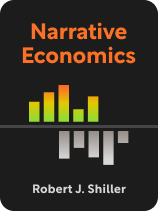
What can we learn about economics by taking a “narrative” approach? How can such a perspective help us predict future economic events?
Robert Shiller’s Narrative Economics acknowledges that numbers and statistics often take center stage in economics. But, we often overlook the influence of narratives and popular ideas. The book shows what we can learn about economics when we consider these additional factors.
Continue reading for an overview of this book that encourages us to look broader and deeper to understand our world.
Overview of Robert Shiller’s Narrative Economics
Robert Shiller’s Narrative Economics explores economic narratives—the stories that people construct to make sense of economic events and behaviors. These stories include both the explanations we give for why certain economic events occur and the meanings and interpretations we assign to those events.
While quantitative data provides valuable insights, it’s equally essential to understand the ways in which economic narratives shape our perceptions of the world. After all, economic events—from bubbles to stock market crashes, recessions, depressions, and panics—are not natural phenomena like weather patterns or the movement of the planets. Instead, they’re the product of human beliefs and the actions that humans take as a result of those beliefs.
According to Shiller, narratives play a crucial role in our understanding of economic events, as they weave together observations into coherent stories that reflect our values. This narrative-driven perspective is deeply rooted in human nature, as research suggests that our brains are hardwired to respond to stories, analogies, and metaphors. Therefore, it’s imperative to explore how and why certain economic narratives emerge, how they come to be accepted, how they influence events, and how they inform our interpretation of subsequent events. Once economists have this understanding, they can better predict future economic events like recessions and stock market crashes and craft more effective and equitable economic policies.
We’ll explore:
- How narratives help us make sense of the world—and how they, in turn, help shape that world
- The factors that contribute to the spread of an economic narrative
- Recurring economic narratives throughout history
- The tools economists can use to anticipate new economic narratives
| Critical Reactions to Narrative Economics Upon its publication in 2019, Narrative Economics received mixed but generally positive reviews from both economists and scholars. The book was praised for its innovative approach—recognizing the importance of narratives and storytelling in shaping economic behavior and trends. Many appreciated Shiller’s exploration of the impact of narratives on financial markets and economic decision-making. A review for the International Monetary Fund acknowledged Shiller’s groundbreaking approach to understanding economic behavior through the lens of narratives and praised his emphasis on the power of stories in shaping economic decisions. However, the reviewer also argued that the book fell short in offering concrete policy recommendations to mitigate the impact of narratives on economic instability. Additionally, the reviewer noted the challenge of quantifying the influence of narratives, arguing that this makes it difficult to apply Shiller’s insights in practice. A different review for the London School of Economics Review of Books commended Shiller’s exploration of the significance of narratives in shaping economic events. The review praised the detailed accounts of various narrative-driven phenomena, including stock market movements, the rise and fall of Bitcoin, and shifts in economic models and ideas. On the other hand, the review suggested that Shiller’s framework may obscure a more fundamental role of narratives in shaping economic behavior. The reviewer argued that individuals don’t merely “catch” narratives like they would “catch” a virus (a metaphor that Shiller uses extensively); rather, narratives are integral to how people imagine and plan for the future in an uncertain world. |
Part 1: The Power of Narrative
Shiller writes that narratives are extraordinarily powerful because they help us make sense of the world. By organizing random events and observations into stories with clear narrative arcs, we come to understand our world, how it came to be, and our place within it.
Shiller points out that we create similar narratives to describe the natural world. As winter approaches in temperate climates, we observe that the trees shed their leaves, many plants go dormant, the landscape becomes barren, and temperatures drop. Based on these observations, we form a narrative that describes winter as a period of rest and reflection for nature. It’s a time when the Earth appears asleep, conserving energy and resources. This narrative directly impacts our beliefs and behavior—we mirror nature’s resting period, leading to cultural traditions like winter holidays and celebrations that emphasize coziness, reflection, and the expectation of renewal in the future.
Economic Narratives Give Meaning to Economic Events
By following this principle, writes Shiller, we use economic narratives to discern meaning in economic events.
An example of this is how people interpret an economic event like a stock market crash. When a significant drop occurs in the stock market, people may construct economic narratives to explain the cause and potential consequences.
Some might attribute the crash to the overvaluation of stocks. They may argue that prices had risen to unsustainable levels due to speculative behavior and an overly optimistic outlook among financial managers in the period leading up to the crash. This narrative suggests that the crash was a necessary correction to realign prices with fundamentals.
Others might interpret the crash as a reflection of broader economic uncertainty. They could argue that factors such as geopolitical tensions, trade disputes, or a global health crisis had created a climate of uncertainty, leading investors to sell off their holdings.
Another narrative could focus on regulatory failures as the cause of the crash. This narrative might claim that lax oversight and inadequate regulation allowed risky financial practices to proliferate, leading to the eventual collapse. Conversely, some individuals might argue that the stock market crash was a result of too much regulation imposed on financial institutions. This narrative would suggest that stringent regulatory requirements and compliance costs had stifled economic growth and innovation. As a consequence, financial markets became less adaptable and resilient, making them more vulnerable to shocks.
These narratives not only help individuals make sense of the stock market crash but also influence their future investment decisions and economic behavior. They shape perceptions of the event, drive market sentiment, and impact market dynamics.
Economic Narratives Shape Economic Behavior
Shiller writes that narratives don’t just help us understand or describe economic events around us—they shape the economic behavior that produces those events. Understanding this dynamic, says Shiller, is crucial for both economists and policymakers. This understanding will enable them to better manage economic events—especially as new communication technology has revolutionized the way narratives spread, enabling them to disseminate more quickly and widely than ever before.
The Bitcoin Narrative
Shiller points to the phenomenon of Bitcoin and other cryptocurrencies as an example of how narratives shape economic events and behaviors.
These digital assets surged in value and popularity in 2020 and 2021, captivating the imagination of investors worldwide. However, the value of cryptocurrencies is not solely, or even primarily, determined by their intrinsic properties; rather, that value is intricately tied to the narratives that envelop them. Those narratives make people want to own Bitcoin, which drives up the bidding war, which in turn enhances the narrative about their allure and value.
According to Shiller, investing in Bitcoin allows people to craft a compelling narrative about the world and their role within it. The unregulated, decentralized nature of cryptocurrencies like Bitcoin appeals to a libertarian, independent, and anarchic desire to reject the authority of governments and big banks. This appeal gained traction in the aftermath of the 2008 financial crisis, a period marked by a decline in trust in traditional financial institutions. Additionally, writes Shiller, many people view cryptocurrencies as a way to earn income passively—offering an alternative to a traditional job in a globalized economy that many see as distorted by mass inequality.
Part 2: Factors That Facilitate Narrative Spread
Now that we’ve explored what economic narratives are and why they’re so powerful, it’s important to understand how people come to accept them. We’ll examine some of the factors that, according to Shiller, contribute to the widespread dissemination of economic narratives: memorable visuals, emotional resonance, influential endorsers, holistic explanations, and a human-centric focus.
Factor #1: Memorable Visuals
Shiller writes that narratives that incorporate easily understandable visual elements gain traction more rapidly. This is because visuals have the power to simplify complex concepts and make them more accessible to a wider audience. Human cognition is inherently inclined towards visual processing, and people tend to grasp visual information more quickly and effectively than text or abstract data.
For example, in the realm of sustainable investing, the narrative of “green bonds” has gained traction in recent years. Green bonds are financial instruments designed to fund environmentally friendly projects such as renewable energy installations, clean transportation, and energy-efficient building projects. What sets green bonds apart is the incorporation of simple visual elements (like color-coded labels and symbols that represent environmentally friendly projects) that resonate with investors and the broader public.
Indeed, the name itself, “green bonds,” evokes an image of environmentally friendly investments. This terminology creates a narrative that aligns with broader goals of sustainability and climate action.
Factor #2: Emotional Resonance
According to Shiller, narratives that evoke powerful emotions, especially those aligned with people’s prior experiences, have a greater impact than those that don’t. This is because emotional engagement is a potent force in shaping human behavior and decision-making. When narratives trigger strong emotions, they become more memorable, relatable, and influential—especially when stories and narratives elicit emotions that people can personally identify with.
The post-2008 global financial crisis narrative of “Main Street vs. Wall Street” was a powerful and emotionally charged economic narrative that gained prominence in public discourse. This narrative tapped into the emotions of many individuals who had experienced the devastating consequences of the financial crisis, including home foreclosures, job losses, and economic hardships.
The “Main Street vs. Wall Street” narrative portrayed a stark contrast between the struggles of everyday citizens on Main Street and the perceived excesses and irresponsibility of financial institutions on Wall Street. This emotionally charged narrative had real-world consequences, leading to calls for greater financial regulation and accountability. In addition, it inspired the Occupy Wall Street movement and served as a rallying cry for individuals seeking economic justice, reform, and measures to curb the excesses of the financial industry. This narrative played a significant role in shaping the economic and political landscape in the years that followed the crisis.
Factor #3: Influential Endorsers
Shiller notes that charismatic and compelling storytellers can significantly amplify narratives. Charismatic storytellers possess the power to engage people emotionally and intellectually, making the narrative more relatable and memorable.
For an example of this, we can look at the story of Elon Musk and his companies, especially Tesla and SpaceX. Musk, known for his charismatic personal leadership, has been a driving force behind two major economic narratives. First, he’s propelled the narrative of electric vehicles (EVs) into the mainstream with Tesla and demonstrated a unique ability to narrate a future where sustainable transportation is not only possible but exciting and inevitable. His narrative paints a picture of a world where EVs are accessible, affordable, and environmentally friendly, appealing to both consumers and investors alike.
Second, with SpaceX, Musk has reshaped the economic narrative of space exploration and commercialization. He tells a story of humanity’s expansion into space, with Mars colonization as a realistic goal. His charismatic storytelling has captivated the public’s imagination and reignited interest in space travel. This narrative has enabled ordinary people to imagine themselves as spacefaring citizens, driving significant new investment in the space industry and garnering support from governments, investors, and space enthusiasts.
Factor #4: Holistic Explanations
Shiller observes that narratives offering comprehensive explanations of complexities have a strong appeal. This is because human beings naturally seek understanding and meaning in the world around them. People are often confronted with complex and multifaceted phenomena, whether in economics, science, politics, or everyday life. In the face of these complexities, individuals are drawn to narratives that promise clarity, coherence, and a sense of order.
The sustainable development narrative illustrates this by offering a framework that integrates economic growth, environmental preservation, and social well-being. This framework provides a coherent view of intricacies like resource management and climate change, so it resonates with those seeking a roadmap for a better future.
Factor #5: Human-Centric Focus
Shiller writes that economic narratives that place human beings at their center are engaging and relatable. This is because people are inherently social beings, so they tend to relate better to stories, concepts, and situations that involve human characters or human experiences. Human-centric economic narratives tap into the audience’s innate social and empathetic nature.
The narrative of the “gig economy” illustrates this idea. The gig economy narrative offers a compelling story of people ditching the time demands of traditional 9 to 5 jobs and living a more flexible and balanced life without the pressure of having a boss and needing to report to the same place every day. As such, the gig economy narrative emphasizes stories of people participating in short-term, flexible, and often technology-driven work arrangements such as ride-share driving or freelance writing. It tells the story of everyday people who leverage their skills, assets, and time to earn income on their own terms. This narrative showcases the experiences of gig workers, highlighting the motivations, challenges, and opportunities they face.
One of the strengths of the gig economy narrative is its relatability. It resonates with the experiences of many who have participated in gig work or considered it as a source of income. It addresses common concerns such as job security, income stability, and work-life balance, making it highly engaging and relatable.
The narrative of the gig economy has sparked discussions about the future of work, labor rights, and the role of technology in reshaping employment opportunities. It explores the human aspects of work, from the desire for autonomy to the challenges of accessing benefits and protections. This focus on people’s experiences and aspirations has made the gig economy narrative a central topic in labor market debates.
Part 3: Recurring Economic Narratives
With our understanding of the power and reach of economic narratives and the factors that facilitate their spread, we can now turn our attention to exploring some of the specific economic narratives that Shiller argues have recurred throughout American history.
These narratives tap into fundamental themes that have shaped our collective understanding of past economic events. Because of the staying power and communicability of these narratives of the past, they influenced how people perceived and reacted to subsequent economic events. This, in turn, means that the narratives themselves come to have a profound influence on future events.
Recurring Narrative #1: Financial Panics and Depressions
Shiller observes that the narratives surrounding what we now refer to as “recessions” or “depressions” have evolved over time.
In the 19th century and early 20th century, these economic downturns were labeled as “panics,” and the narrative that prevailed was one of fear and loss of confidence. This belief in a narrative of panic shaped what ordinary people and elected leaders saw as the appropriate response. They believed that only great figures, like financier J.P. Morgan, could restore order and quell the panic through single-handed confidence, influence, and decisiveness. This is why Morgan personally assembled a coalition of bankers and financiers to inject liquidity into the banking system during the Panic of 1907.
Recurring Narrative #2: The American Dream
As Shiller notes, the narrative of the American Dream—the concept that America is a land of opportunity, where hard work can lead to the realization of one’s fullest potential without interference—is deeply ingrained in the national narrative.
In the United States, the prevailing belief is in a pure meritocracy, where an individual’s only limitation is their innate ability and the effort they’re willing to put in. This narrative of opportunity and meritocracy began to evolve in the 1930s, and advertisers and marketers soon seized upon it to promote their products as embodiments of the American dream. Everything, from savings accounts and automobiles to suburban homes and home appliances, was presented as either a tool to help individuals achieve the American dream or a status symbol signaling to others that they’d already achieved it.
Shiller writes that the narrative of the American dream has significant economic consequences. On one hand, it increases consumer demand. The belief that anyone can improve their economic standing through hard work motivates people to strive for better living standards, which fuels spending and economic growth. However, this narrative also has a downside, as it can drive people into debt. Many people feel a pressure to consume, often beyond their means, in pursuit of the American dream. This drive to keep up with societal expectations and realize their version of the dream can lead to financial strain and cumbersome personal debt.
Recurring Narrative #3: The Gold Standard
Shiller writes that the narrative of the gold standard—a “hard” currency backed by the value of something tangible, like gold—has been a recurring American economic narrative. Different groups have argued over the centuries about the merits and pitfalls of a hard currency system—generally with the wealthy being in favor of a currency backed by a tangible asset like gold, and economically disadvantaged Americans supporting fiat currencies (government-issued money not backed up by a tangible asset).
In the 19th century, according to Shiller, there was a prevailing belief that backing dollars with gold was a way to uphold truth and virtue, essentially extending moral qualities to the currency itself by tying it to something “real” and solid. This gold standard, seen as a bedrock of financial integrity, was rooted in the idea that a currency’s value should be directly connected to a tangible asset like gold. The popular sentiment was that “strong money” equated to “strong morals.”
The gold standard narrative thus acquired a moral and emotional charge that pitted different classes against one another. Typically, wealthier Americans based in the banking centers of the East, who were often creditors, favored the continuation of a gold standard; poorer Americans, who were often indebted, working in agriculture, and based in the Midwest and West, favored a coinage system that was based on both gold and silver at defined ratios (“bimetallism”).
The bimetallists saw themselves as champions of the common people, believing their monetary policies would enable inflation, which in turn would reduce the real value of people’s debts. In response, the gold standard stalwarts (“goldbugs”) clung to the narrative that straying from the gold standard was synonymous with irresponsibility, shiftlessness, and loose morals. These attitudes drove the “hard money” policies that persisted until the gold standard was dismantled in a series of developments throughout the 20th century.
Recurring Narrative #4: The Machines Are Coming for Your Job
Shiller writes that fears of technological unemployment have persisted throughout history, from the industrial age to the present era of AI and automation. Indeed, he writes that the fear that machines will eventually replace human labor is a narrative with deep historical roots, dating back to the ancient Greeks. Throughout history, every significant technological advance has rekindled this narrative, often accompanied by riots and fierce protests as people grapple with the implications of automation.
This narrative gained momentum, Shiller notes, with the onset of the industrial age and continued well into the early 20th century. It reached its peak during the 1930s when many people attributed the Great Depression to technological unemployment. During this period, the fear that machines could displace human jobs was palpable, and it fueled concerns about economic stability and inequality.
The Emerging AI Narrative
In the modern era, writes Shiller, computers and AI represent the latest manifestation of this narrative. Just as engines and machines once replaced physical labor, AI and computers are now poised to replace intellectual labor. The concern is that if workers accept this narrative too deeply and come to fear their jobs will be automated in the near future, they may curtail their spending now, anticipating economic uncertainty. This reduction in consumer spending could lead to a decrease in overall demand, potentially triggering a recession. And, in a neat illustration of the self-reinforcing power of economic narratives, a recession might incentivize employers to invest more in money-saving automation as they seek to cut costs, perpetuating the cycle.
Part 4: Predicting Tomorrow’s Narratives
Having explored what factors make certain economic narratives “stick” and which economic narratives have had staying power throughout history, Shiller writes that we need to develop tools that help us predict and prepare for the narratives that will take hold in the future. Given the real economic power that narratives hold, it is essential to understand their origins, propagation, and eventual decline. Shiller recommends that economists do this by embracing qualitative (in addition to quantitative) research and by looking for new sources of narratives in traditionally overlooked places.
Shifting to Qualitative Research
Shiller writes that economists must venture beyond their traditional quantitative approaches and pay heed to the emotions and impulses that shape the decisions of the real people who constitute the economy. This shift calls for a more nuanced and multidisciplinary approach.
To gain a deeper understanding of how narratives influence economic behavior, economists should engage in qualitative research methods. This includes conducting interviews with individuals, organizing focus groups, and undertaking longitudinal studies to measure how attitudes and beliefs evolve over time. Collaborating with experts in psychology and sociology can offer valuable insights into the cognitive processes that drive the formation and spread of narratives.
Finding New Sources
Moreover, writes Shiller, economists should broaden the scope of their work by analyzing sentiments and ideas found in sources that have typically been overlooked in traditional economic analyses. These sources include anything from sermons, social media posts, pop culture references, and memes to advertisements and historical documents like diaries, land deeds, wills, and newspaper editorials. These diverse sources provide windows into how ordinary people throughout history have thought about and engaged with economic concepts.
Shiller’s call for economists to tap into previously overlooked data sources to better understand economic narratives reminds us that our traditional quantitative sources—government statistics, industry data, and official demographics—only began being compiled and published recently.

———End of Preview———
Like what you just read? Read the rest of the world's best book summary and analysis of Robert J. Shiller's "Narrative Economics" at Shortform.
Here's what you'll find in our full Narrative Economics summary:
- How human beliefs and actions, not statistics, drive economic outcomes
- The factors that contribute to the spread of economic narratives
- The significant economic consequences of the American Dream






